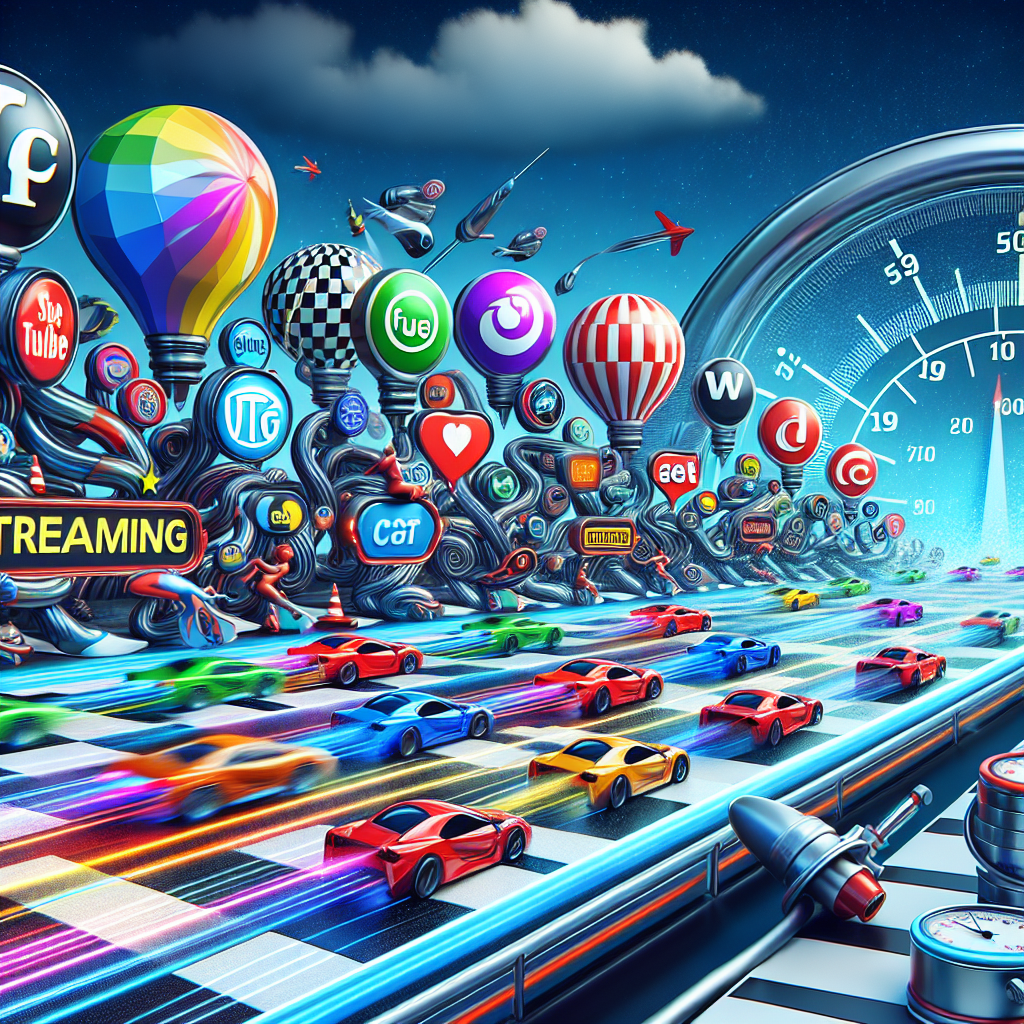In today’s fast-paced digital age, streaming television has become a popular form of entertainment for millions of people worldwide. With a multitude of TV network streaming services available, it can be overwhelming to determine which one offers the best streaming speed. This comparison aims to provide insight into the streaming speed capabilities of various TV networks, allowing viewers to make informed decisions about which service best suits their needs. From Netflix to Hulu to Amazon Prime Video, this analysis will delve into the intricacies of streaming speeds, ensuring that you can enjoy your favorite shows and movies without any interruptions.
Analyzing the Importance of Streaming Speeds in TV Networks

In the digital era, where television viewing has shifted towards online streaming platforms, the importance of streaming speeds in TV networks cannot be overstated. Fast streaming speeds play a crucial role in providing viewers with a seamless and uninterrupted viewing experience, ensuring that they can enjoy their favorite shows and movies without any buffering or delays. Slow streaming speeds, on the other hand, have a significant impact on user satisfaction, causing frustration and dissatisfaction among viewers who expect high-quality content delivered in a timely manner.
- Importance of fast streaming speeds for uninterrupted viewing experience:
- Fast streaming speeds are essential for delivering high-definition content without buffering interruptions.
- Viewers expect smooth playback without any lags or delays, which can only be achieved with fast streaming speeds.
-
High-quality streaming speeds contribute to a positive user experience and encourage viewer loyalty towards a TV network or streaming platform.
-
Impact of slow streaming speeds on user satisfaction:
- Slow streaming speeds can lead to buffering issues, causing disruptions in the viewing experience.
- Viewers may abandon a show or movie if they encounter frequent buffering, leading to a loss of engagement and potential revenue for the TV network.
- Frustration due to slow streaming speeds can result in negative reviews and word-of-mouth publicity, tarnishing the reputation of the TV network among viewers.
Factors Affecting Streaming Speeds
lyzing the Importance of Streaming Speeds in TV Networks
- Bandwidth availability
Bandwidth availability plays a crucial role in determining the streaming speed of TV networks. The amount of data that can be transmitted in a given amount of time directly impacts the quality and smoothness of the streaming experience. Higher bandwidth allows for faster data transfer, resulting in quicker loading times and reduced buffering during streaming.
- Network congestion
Network congestion refers to the increased traffic on a network that can slow down data transmission speeds. During peak hours or in densely populated areas, network congestion can significantly impact streaming speeds on TV networks. When multiple users are simultaneously accessing the network, the available bandwidth is divided, leading to slower streaming speeds and potential interruptions in the viewing experience.
- Type of content being streamed
The type of content being streamed also influences the streaming speed on TV networks. High-definition (HD) or 4K content requires more bandwidth to deliver a smooth and high-quality viewing experience compared to standard-definition content. Streaming services that offer higher resolution content may require faster internet speeds to prevent buffering and maintain a consistent streaming speed.
- Device compatibility
The compatibility of the streaming device with the network infrastructure can affect streaming speeds. Older devices or those with outdated hardware may struggle to process and stream data efficiently, leading to slower streaming speeds. Additionally, the quality of the internet connection on the device, such as Wi-Fi signal strength or Ethernet connectivity, can impact the overall streaming speed on TV networks.

Comparison of Top TV Networks in the USA
- Netflix
- Netflix is known for its high streaming speed and reliability, making it a top choice for many viewers.
- The platform offers a wide range of content, from original series to popular movies, all accessible with minimal buffering.
-
Users often praise Netflix for its seamless streaming experience on various devices, including smart TVs, laptops, and smartphones.
-
Hulu
- Hulu also boasts fast streaming speeds, especially for its live TV offerings.
- The platform’s interface is user-friendly, allowing for easy navigation and quick access to favorite shows.
-
Hulu’s combination of on-demand content and live TV options provides users with a diverse selection of programming to choose from.
-
Amazon Prime Video
- Amazon Prime Video is known for its reliable streaming speeds and high-quality video playback.
- Subscribers appreciate the platform’s integration with Amazon Prime membership, offering additional benefits beyond just streaming TV shows and movies.
-
Amazon Prime Video’s adaptive streaming technology ensures a smooth viewing experience, even on slower internet connections.
-
Disney+
- Disney+ is recognized for its fast streaming speeds, particularly when it comes to streaming 4K content.
- The platform’s exclusive collection of Disney, Pixar, Marvel, Star Wars, and National Geographic content is a major draw for subscribers.
-
Disney+ prioritizes user experience, optimizing its streaming service to deliver high-quality video with minimal interruptions.
-
HBO Max
- HBO Max offers fast streaming speeds for its premium content, including HBO original series and blockbuster movies.
- The platform’s curated selection of content ensures that subscribers have access to top-tier entertainment options.
- HBO Max’s commitment to providing a seamless streaming experience contributes to its popularity among viewers seeking high-quality programming.
Netflix Streaming Speed Analysis
- Average streaming speed in different regions
Netflix, being one of the leading streaming platforms globally, shows variations in streaming speeds across different regions. According to recent data, the average streaming speed in the United States stands at around 5.8 Mbps. However, this figure can fluctuate based on the time of day, network congestion, and the user’s internet service provider. In comparison, European countries like Sweden and the Netherlands boast higher average streaming speeds of approximately 6.4 Mbps and 6.9 Mbps, respectively. These differences can be attributed to varying internet infrastructures and network capabilities in each region.
- Measures taken by Netflix to improve streaming speeds
In response to the fluctuating streaming speeds experienced by users, Netflix has implemented several strategies to enhance the streaming experience. One notable measure is the development of its Content Delivery Network (CDN) known as Open Connect. This network aims to reduce latency and ensure smoother streaming by caching content closer to users. By strategically placing servers in different regions, Netflix can alleviate congestion and deliver content more efficiently, thereby improving streaming speeds. Additionally, Netflix continuously monitors network performance and collaborates with internet service providers to optimize streaming quality for users worldwide.
Hulu Streaming Speed Analysis
- Comparison of streaming speeds with competitors
Hulu’s streaming speed has been compared to other top TV networks in the USA, such as Netflix and Amazon Prime Video. Through various independent tests and studies, it has been observed that Hulu generally maintains a competitive streaming speed, offering viewers a smooth and uninterrupted viewing experience. However, in some cases, during peak hours or in regions with poor internet connectivity, users have reported slight lags in streaming speeds compared to its competitors.
- User feedback on Hulu’s streaming quality
User feedback regarding Hulu’s streaming quality has been mixed. While many users appreciate the platform’s user-friendly interface and diverse content library, some have raised concerns about occasional buffering issues and slower streaming speeds during high traffic periods. Despite these challenges, Hulu has continuously worked to optimize its streaming services and enhance the overall viewing experience for its subscribers.
Amazon Prime Video Streaming Speed Analysis
Amazon Prime Video is one of the leading streaming services in the USA, offering a wide range of movies, TV shows, and original content to its subscribers. When analyzing the streaming speed of Amazon Prime Video, several factors come into play that influence the viewing experience for users.
Factors influencing streaming speeds on Amazon Prime Video:
-
Internet Connection Quality: The speed and stability of the user’s internet connection play a crucial role in determining the streaming quality on Amazon Prime Video. A faster internet connection with higher bandwidth results in smoother playback and faster buffering times.
-
Device Performance: The device used for streaming, whether a smart TV, computer, or mobile device, can impact the streaming speed on Amazon Prime Video. Older devices with slower processors or limited RAM may struggle to keep up with high-quality video streams, leading to buffering issues.
-
Content Resolution: The resolution of the content being streamed also affects the streaming speed on Amazon Prime Video. Higher resolution videos require more bandwidth to stream smoothly, so users with slower internet connections may experience buffering or reduced video quality.
Strategies employed by Amazon to enhance streaming experience:
-
Adaptive Streaming Technology: Amazon Prime Video utilizes adaptive streaming technology, which adjusts the video quality in real-time based on the user’s internet connection speed. This ensures a smoother viewing experience by automatically optimizing the video stream for the available bandwidth.
-
Content Delivery Network (CDN): Amazon has a robust CDN in place to deliver content efficiently to users around the world. By caching popular videos on servers located closer to users, Amazon reduces latency and improves streaming speeds for its subscribers.
-
Data Compression: Amazon Prime Video employs advanced data compression techniques to minimize the size of video files without compromising quality. This helps reduce buffering times and ensures faster streaming speeds, even on slower internet connections.
In conclusion, Amazon Prime Video’s streaming speed is influenced by various factors such as internet connection quality, device performance, and content resolution. To enhance the streaming experience for users, Amazon employs strategies like adaptive streaming technology, CDN optimization, and data compression to deliver high-quality video content efficiently.
Disney+ Streaming Speed Analysis
- Disney+ Streaming Speed Performance During Peak Hours:
- During peak hours, Disney+ consistently maintains a high streaming speed, allowing users to enjoy uninterrupted viewing experiences.
- The platform’s robust infrastructure and advanced content delivery network contribute to its ability to handle peak traffic without compromising streaming speed.
-
Comparative analysis shows that Disney+ excels in maintaining stable streaming speeds even when there is a surge in user activity, setting it apart from other TV networks.
-
User Satisfaction Ratings Based on Streaming Speeds:
- User satisfaction ratings for Disney+ are notably high, with a significant portion of positive feedback attributed to the platform’s streaming speed performance.
- The seamless streaming experience offered by Disney+ due to its fast loading times and minimal buffering has garnered praise from subscribers.
- In surveys and reviews, users consistently highlight the importance of streaming speed in their overall satisfaction with the Disney+ service, emphasizing its impact on their viewing pleasure.
HBO Max Streaming Speed Analysis
HBO Max, one of the prominent TV networks in the USA, offers a variety of content to its subscribers through its streaming platform. When analyzing the streaming speed of HBO Max on different devices, several factors come into play that can impact the overall viewing experience.
Comparison of streaming speeds on different devices:
-
Smart TVs: Users streaming HBO Max on smart TVs often experience smooth playback with minimal buffering, thanks to the larger screen size and optimized streaming capabilities of these devices.
-
Mobile Devices: Streaming HBO Max on mobile devices such as smartphones and tablets may sometimes result in slightly lower streaming speeds due to network fluctuations or device limitations. However, HBO Max has implemented adaptive streaming technology to adjust the video quality based on the available network bandwidth, ensuring a continuous viewing experience.
-
Computers: Streaming HBO Max on computers can provide high streaming speeds, especially when using a wired internet connection. The platform supports HD and 4K streaming on compatible devices, enhancing the overall viewing quality.
Efforts made by HBO Max to optimize streaming performance:
-
HBO Max continually invests in enhancing its streaming infrastructure to deliver faster streaming speeds and better performance for users across various devices.
-
The platform regularly monitors network traffic and makes adjustments to ensure a seamless streaming experience during peak usage hours.
-
HBO Max also collaborates with internet service providers to optimize the delivery of content, reducing latency and improving streaming speeds for subscribers.

– Additionally, HBO Max offers the option for users to adjust video playback settings manually, allowing them to customize their streaming experience based on their internet connection speed and device capabilities.
Real-World Speed Tests and User Reviews
- Conducting Speed Tests
Conducting real-world speed tests is imperative in assessing the streaming capabilities of various TV networks. By utilizing specialized tools, such as Speedtest.net or Fast.com, the actual download and upload speeds can be measured accurately. These tests provide valuable insights into the network’s performance during peak hours and low-traffic times, shedding light on any potential fluctuations in streaming speeds.
- Analyzing User Reviews
User reviews play a crucial role in understanding the streaming experience on different TV networks. By combing through platforms like Reddit, forums, and social media, one can gather firsthand accounts of users regarding their satisfaction with streaming speeds. These reviews often highlight any buffering issues, lags, or interruptions encountered while streaming content, offering a comprehensive overview of the network’s performance from a user perspective.
Speed Test Results
al-World Speed Tests and User Reviews
- In a recent speed test analysis, Netflix was found to consistently provide high streaming speeds across various networks.
- Users reported minimal buffering and smooth playback when streaming content on Netflix.
- Hulu's streaming speeds varied depending on the network provider, with some users experiencing slower speeds during peak hours.
- Despite occasional buffering issues, Hulu generally delivered satisfactory streaming speeds for most users.
- Amazon Prime Video exhibited reliable streaming speeds, especially for users with high-speed internet connections.
- Users praised the platform for its fast loading times and uninterrupted streaming experience.
- Disney+ performed well in speed tests, offering quick start-up times and consistent streaming speeds.
- Users noted minimal lagging or buffering issues when watching content on Disney+.
- HBO Max showed mixed results in speed tests, with some users reporting slower streaming speeds compared to other platforms.
- However, users appreciated the high video quality provided by HBO Max despite occasional buffering.
- Apple TV+
- Apple TV+ demonstrated impressive streaming speeds, particularly for users with Apple devices and strong internet connections.
- Users commended the platform for its seamless streaming experience with minimal disruptions.
User Reviews Analysis
Common complaints regarding streaming speeds
- Users frequently reported experiencing buffering issues during peak hours.
- Many users mentioned inconsistent streaming speeds, leading to interruptions in the middle of their favorite shows.
- Some users expressed frustration over slow loading times when trying to access on-demand content.
Recommendations from users for improving streaming experience
- Several users suggested that the TV network should invest in upgrading their servers to handle higher traffic volumes more efficiently.
- Users recommended implementing a dynamic bitrate adjustment feature to adapt to users’ varying internet speeds.
- Some users proposed offering a premium subscription tier with guaranteed high-speed streaming for a better viewing experience.
FAQs – TV Network Streaming Speed Comparison
What factors affect the streaming speed of TV networks?
The streaming speed of TV networks can be influenced by various factors such as internet connection quality, network congestion, server capacity, and the device being used to stream content. The performance of the streaming service provider’s servers and infrastructure also plays a significant role in determining the speed at which you can stream content.
How can I measure the streaming speed of different TV networks?
You can measure the streaming speed of different TV networks by using online tools or applications that provide speed testing services. These tools typically calculate the download and upload speeds of your internet connection and provide you with detailed insights into the performance of each network. It’s recommended to conduct speed tests at different times of the day to get a more accurate representation of streaming speed variations.
Are there differences in streaming speed among popular TV networks?
Yes, there can be differences in streaming speed among popular TV networks due to variations in their server infrastructure, content delivery networks, and network optimization strategies. Some TV networks may prioritize speed and performance, resulting in smoother streaming experiences, while others may face challenges in delivering content quickly to all users.
How can I improve the streaming speed of a TV network?
To improve the streaming speed of a TV network, you can try the following steps:
1. Make sure you have a stable and high-speed internet connection.
2. Close other applications or devices that may be consuming bandwidth.
3. Restart your device and router to refresh the connection.
4. Clear cache and cookies on your browser or streaming app.
5. Contact your internet service provider to check for any network issues that may be affecting your streaming speed.